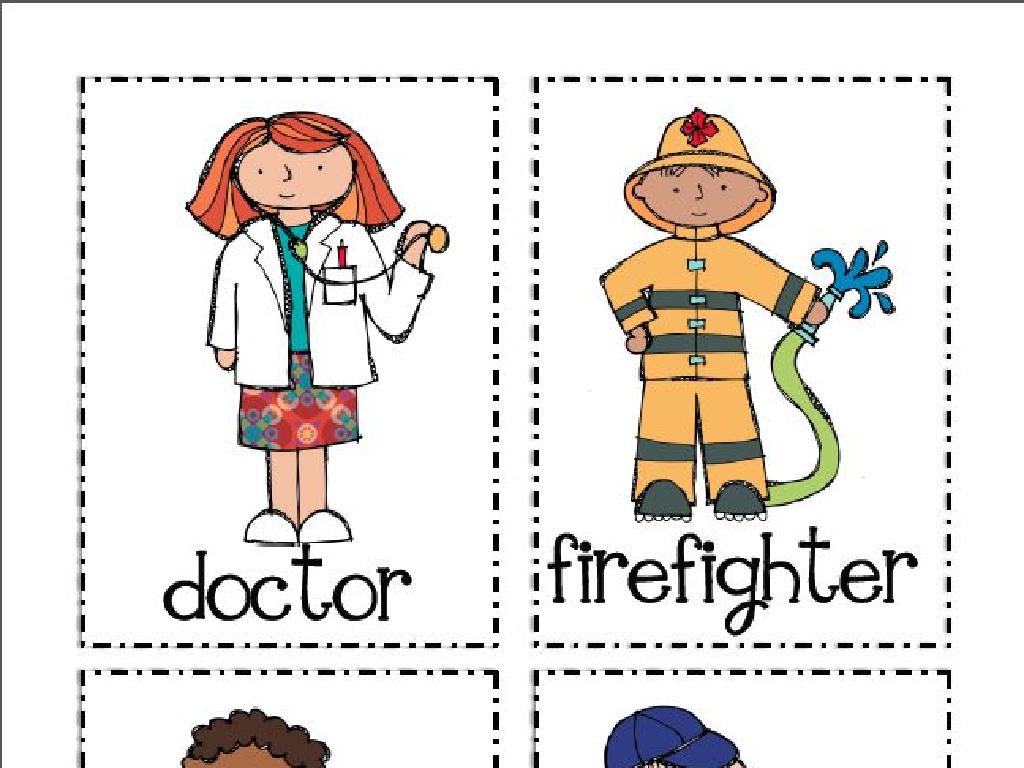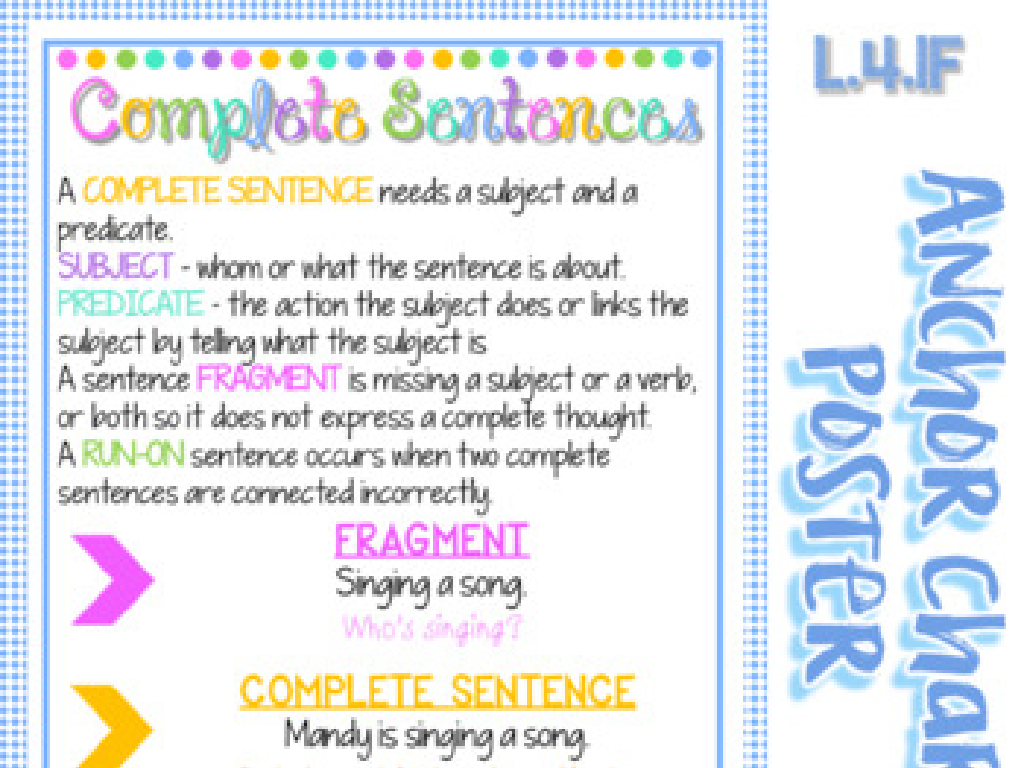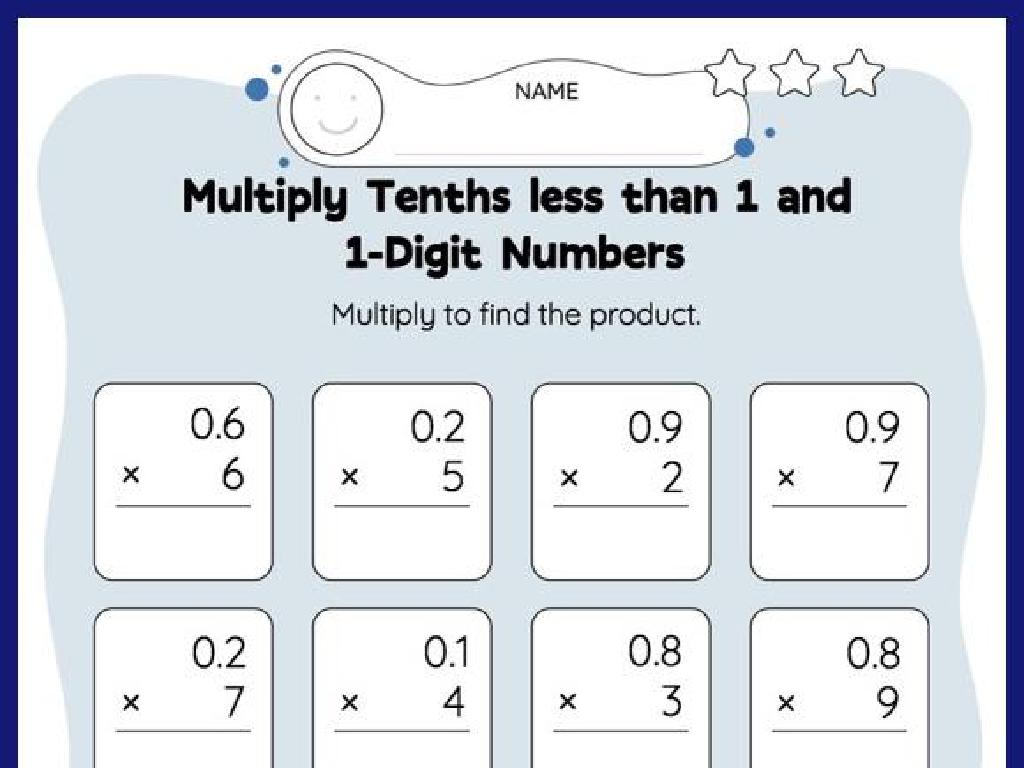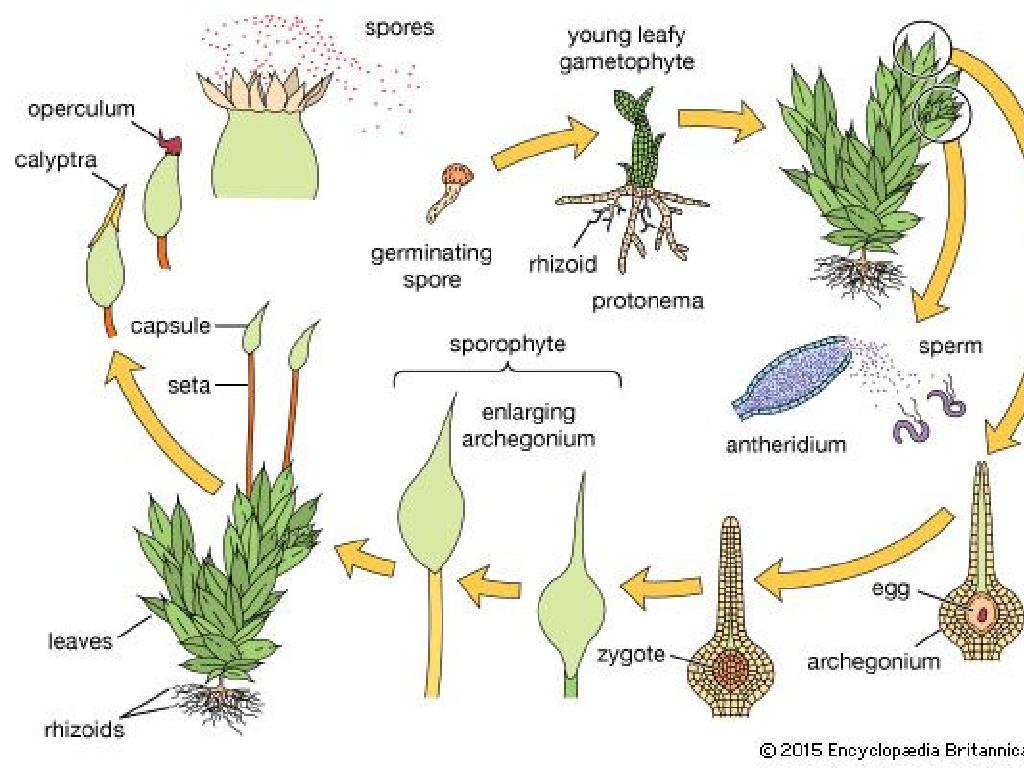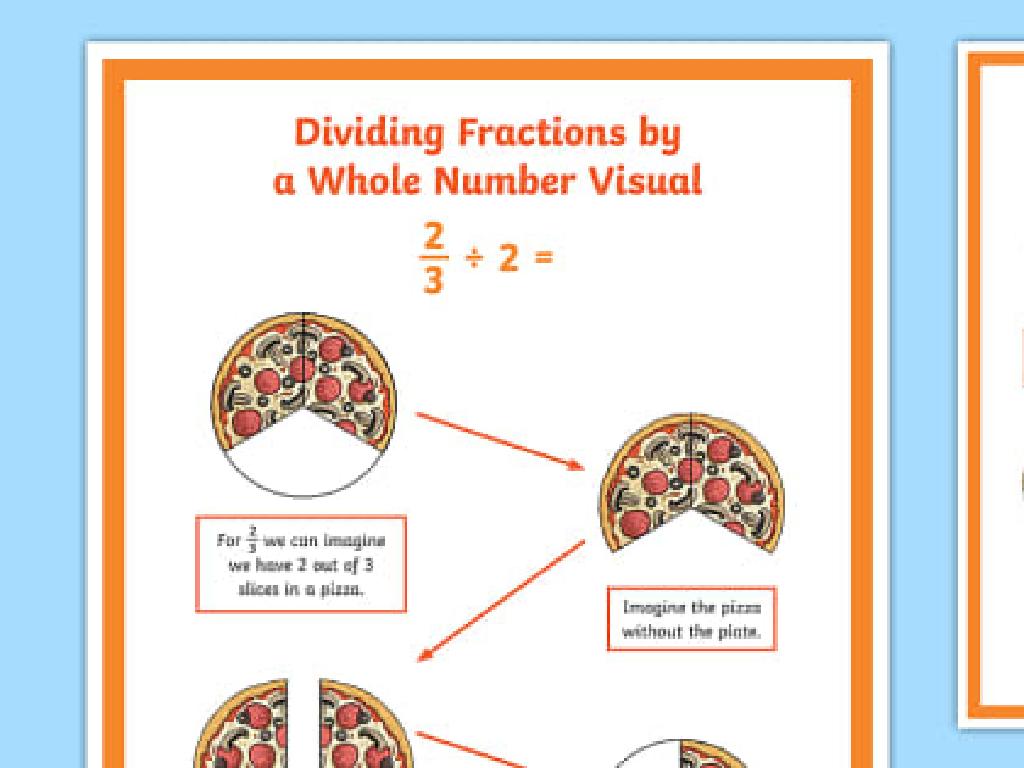Divide 2-Digit Numbers By 1-Digit Numbers: Word Problems
Subject: Math
Grade: Fourth grade
Topic: Division Word Problems
Please LOG IN to download the presentation. Access is available to registered users only.
View More Content
Welcome to Division Word Problems!
– Understanding division: Sharing equally
– Division means splitting into equal parts or groups.
– Today’s goal: Tackle 2-digit/1-digit division
– We’ll learn to divide numbers like 56 ÷ 8 using stories.
– Division’s role in daily life
– It helps us in situations like sharing snacks fairly.
– Practice with real-world problems
– Examples: Dividing pizza slices or pages to read nightly.
|
This slide introduces the concept of division as a method of sharing equally among a number of people or things. Emphasize that division is not just a mathematical operation but a skill used in everyday life, such as sharing food or organizing tasks evenly. Today’s goal is to help students feel comfortable dividing 2-digit numbers by 1-digit numbers within the context of word problems. Provide examples that relate to their experiences, like dividing a set of crayons among friends or splitting a bag of apples. Encourage students to think of division as a fair way to distribute items and to see the practical applications of math in their daily lives. The real-world problems will help solidify their understanding and show them the value of division outside the classroom.
Understanding Division with Word Problems
– Division: a basic math operation
– Explains how numbers are divided
– How often does one number fit into another?
– Example: apples and baskets
– 10 apples divided by 2 baskets equals 5 apples per basket
– Solving division word problems
– Use division to solve problems in stories
|
Division is a fundamental concept in mathematics that fourth graders need to understand. It’s one of the four basic operations and it helps us figure out how many times one number is contained within another. For example, if we have 10 apples and we want to divide them equally into 2 baskets, we would use division to find out that each basket gets 5 apples. This concept can be applied to many real-life situations, which is why word problems are an excellent way to practice division. Encourage students to visualize the problem and relate it to their own experiences. In the next class, we’ll work on more word problems that involve dividing 2-digit numbers by 1-digit numbers to help solidify their understanding of division.
Key Vocabulary in Division
– Dividend: Number being divided
– Divisor: Number you divide by
– Quotient: Result of division
– Remainder: Left over after division
– If 25 is divided by 4, the remainder is 1 because 4 goes into 25 six times with 1 left over.
|
This slide introduces the fundamental vocabulary necessary for understanding division word problems. The dividend is the number that we want to split into equal parts. The divisor is the number of equal parts we are splitting the dividend into. The quotient is the number of times the divisor fits into the dividend. Lastly, the remainder is what’s left over if the dividend doesn’t divide evenly by the divisor. Use examples to illustrate these terms, such as dividing candies among friends. For instance, if we have 25 candies and 4 friends, each friend gets 6 candies (quotient), and 1 candy remains (remainder). Encourage students to think of real-life situations where they share things to understand these concepts better.
Understanding Division Word Problems
– Read the problem carefully
– Identify numbers and the question
– Look for division keywords
– Words like ‘each’, ‘per’, ‘share equally’ hint at division
– Practice with an example
– If 24 apples are shared equally among 8 friends, how many does each get?
|
This slide is aimed at helping students approach division word problems methodically. Start by encouraging them to read the problem multiple times to fully understand it. They should then pinpoint the numbers given and clarify what the problem is asking them to find. Emphasize the importance of looking for keywords that suggest division, such as ‘each’, ‘per’, and ‘share equally’. These words often indicate that the total amount should be divided into equal parts. To reinforce the concept, walk through an example problem as a class. For instance, if there are 24 apples to be shared equally among 8 friends, ask the students how they would figure out the number of apples per friend. This interactive approach will help solidify their understanding of division in real-world contexts.
Dividing Cookies Among Children
– Understanding the problem
– We have 24 cookies to share with 4 children evenly.
– Identifying numbers to divide
– Dividend is 24 (cookies), and divisor is 4 (children).
– Performing the division
– Divide 24 by 4 to find out the number of cookies per child.
– Finding the quotient
– Quotient represents cookies each child will get.
|
This slide presents a word problem to help students understand division in a practical context. The problem involves dividing a set of items (cookies) among a group (children) to find out how many items each group member gets. Start by reading the problem and understanding what is being asked. Identify the total number of items (dividend) and the number of groups or individuals (divisor). Perform the division operation to find the quotient, which in this case will tell us how many cookies each child receives. The answer to the problem is the quotient, which is the result of dividing the dividend by the divisor. Encourage students to visualize the problem and use objects or drawings to represent the division if necessary. This will help them better understand the concept of division as sharing equally.
Let’s Practice Division with Word Problems!
– Gardener’s flower rows
– 36 flowers into 6 rows: How many in each?
– Baker’s cupcake boxes
– 48 cupcakes into boxes of 8: How many boxes?
|
This slide is designed for a class activity where students will practice dividing 2-digit numbers by 1-digit numbers through word problems. For the first problem, guide the students to divide 36 (the total number of flowers) by 6 (the number of rows) to find out how many flowers will be in each row. For the second problem, instruct them to divide 48 (the total number of cupcakes) by 8 (the number of cupcakes per box) to determine the number of boxes needed. Encourage students to visualize the problems, perhaps by drawing a simple diagram or using physical objects to represent the flowers and cupcakes. Provide additional support for students who need it and challenge those who finish early with similar problems to solve.
Strategies for Solving Division Word Problems
– Underline the question in the problem
– Circle numbers and keywords
– Draw a model to visualize the problem
– For example, use blocks or pictures to represent the problem
– Check work by multiplying
– After dividing, multiply the divisor by your answer to see if it equals the dividend
|
This slide is aimed at providing students with a structured approach to solving division word problems. Start by underlining the question to focus on what is being asked. Then, circle the numbers and keywords to highlight important information. Drawing a model, such as a picture or using blocks, can help students visualize the division process. Finally, checking work is crucial; students should multiply their quotient by the divisor to verify their answer. Encourage students to use these strategies in a step-by-step manner for each word problem they encounter. Provide several practice problems for students to apply these strategies and reinforce their understanding.
Independent Practice: Division Word Problems
– Solve workbook division problems
– Use learned strategies for solving
– Remember to draw pictures or use grouping
– It’s okay to ask for help
– Teachers and friends can be your guides
– Practice makes perfect
|
This slide is aimed at guiding students through independent practice of division word problems. Encourage them to apply the strategies learned in class, such as drawing models, using grouping, or creating arrays to visualize the problems. Remind them that it’s perfectly fine to seek assistance if they encounter difficulties. Reinforce the idea that practice is essential for mastering division. Provide several different word problems in the workbook for students to solve, ensuring a range of difficulties to cater to all levels of understanding within the class. Offer support and facilitate peer discussion to help students work through challenging problems.
Class Activity: Division Bingo
– Receive your Division Bingo card
– Listen to division word problems
– Solve problems and find quotients
– Use division skills to solve problems
– Mark correct quotients for Bingo!
– Get five in a row and shout ‘Bingo!’
|
This interactive activity is designed to help students practice dividing 2-digit numbers by 1-digit numbers through a fun game of Bingo. Each student will receive a Bingo card populated with various quotients. As the teacher reads out word problems, students will solve them and mark the corresponding quotient on their Bingo cards. The first student to align five correct quotients in a row, either horizontally, vertically, or diagonally, will call out ‘Bingo!’ and we will review their answers as a class to confirm. This activity not only reinforces division skills but also encourages listening comprehension and quick problem-solving. Prepare a set of diverse word problems and ensure that all possible quotients are represented on the Bingo cards. Have additional problems ready in case of a tie or if students reach Bingo simultaneously.
Great Work and Homework Assignment
– Congratulations on learning division!
– Complete the worksheet for practice
– Solve additional word problems to master division
– Bring questions to the next class
– Don’t hesitate to ask for help with tricky problems
– Keep practicing division skills
|
This slide marks the conclusion of the lesson on division word problems and transitions students to their homework assignment. The worksheet provided should contain a variety of word problems that require students to apply the division skills they’ve learned in class. Encourage students to attempt all problems and reassure them that it’s okay to have questions; the next class will provide an opportunity for clarification. Remind them that practice is key to becoming proficient in division. For the teacher: Prepare a worksheet with diverse problems, some of which should be challenging to push higher-level thinking. Be ready to address common issues in the next session and consider pairing students for peer tutoring if necessary.

